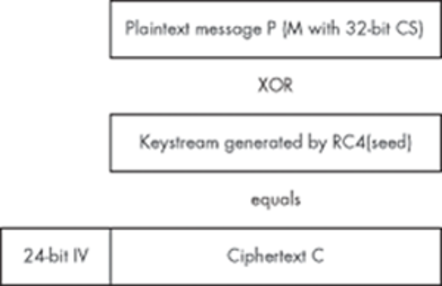Wireless 802.11b security has been a big issue, primarily due to the absence of it. Weaknesses in Wired Equivalent Privacy (WEP), the encryption method used for wireless, contribute greatly to the overall insecurity. There are other details, sometimes ignored during wireless deployments, which can also lead to major vulnerabilities.
The fact that wireless networks exist on layer 2 is one of these details. If the wireless network isn't VLANed off or firewalled, an attacker associated to the wireless access point could redirect all the wired network traffic out over the wireless via ARP redirection. This, coupled with the tendency to hook wireless access points to internal private networks, can lead to some serious vulnerabilities.
Of course, if WEP is turned on, only clients with the proper WEP key will be allowed to associate to the access point. If WEP is secure, there shouldn't be any concern about rogue attackers associating and causing havoc. This begs the question, "How secure is WEP?"
1. Wired Equivalent Privacy
WEP was meant to be an encryption method providing security equivalent to a wired access point. It was originally designed with 40-bit keys; later, WEP2 came along to increase the key size to 104 bits. All of the encryption is done on a per-packet basis, so each packet is essentially a separate plaintext message to send. The packet will be called M.
First, a checksum of message M is computed, so the message integrity can be checked later. This is done using a 32-bit cyclic redundancy checksum function aptly named CRC32. This checksum will be called CS, so CS = CRC32(M). This value is appended to the end of the message, which makes up the plaintext message P:

Now, the plaintext message needs to be encrypted. This is done using RC4, which is a stream cipher. This cipher, initialized with a seed value, can generate a keystream, which is just an arbitrarily long stream of pseudorandom bytes. WEP uses an initialization vector (IV) for the seed value. The IV consists of 24 bits generated for each packet. Some older WEP implementations simply use sequential values for the IV, while others use some form of pseudo-randomizer.
Regardless of how the 24 bits of IV are chosen, they are prepended to the WEP key. (These 24 bits of IV are included in the WEP key size in a bit of clever marketing spin; when a vendor talks about 64-bit or 128-bit WEP keys, the actual keys are only 40 bits and 104 bits, respectively, combined with 24 bits of IV.) The IV and the WEP key together make up the seed value, which will be called S.

Then the seed value S is fed into RC4, which will generate a keystream. This keystream is XORed with the plaintext message P to produce the ciphertext C. The IV is prepended to the ciphertext, and the whole thing is encapsulated with yet another header and sent out over the radio link.

When the recipient receives a WEP-encrypted packet, the process is simply reversed. The recipient pulls the IV from the message and then concatenates the IV with his own WEP key to produce a seed value of S. If the sender and receiver both have the same WEP key, the seed values will be the same. This seed is fed into RC4 again to produce the same keystream, which is XORed with the rest of the encrypted message. This will produce the original plaintext message, consisting of the packet message M concatenated with the integrity checksum CS. The recipient then uses the same CRC32 function to recalculate the checksum for M and checks that the calculated value matches the received value of CS. If the checksums match, the packet is passed on. Otherwise, there were too many transmission errors or the WEP keys didn't match, and the packet is dropped.
That's basically WEP in a nutshell.
2. RC4 Stream Cipher
RC4 is a surprisingly simple algorithm. It consists of two algorithms: the Key Scheduling Algorithm (KSA) and the Pseudo-Random Generation Algorithm (PRGA). Both of these algorithms use an 8-by-8 S-box, which is just an array of 256 numbers that are both unique and range in value from 0 to 255. Stated simply, all the numbers from 0 to 255 exist in the array, but they're all just mixed up in different ways. The KSA does the initial scrambling of the S-box, based on the seed value fed into it, and the seed can be up to 256 bits long.
First, the S-box array is filled with sequential values from 0 to 255. This array will be aptly named S. Then, another 256-byte array is filled with the seed value, repeating as necessary until the entire array is filled. This array will be named K. Then the S array is scrambled using the following pseudo-code.
j = 0;
for i = 0 to 255
{
j = (j + S[i] + K[i]) mod 256;
swap S[i] and S[j];
}
Once that is done, the S-box is all mixed up based on the seed value. That's the key scheduling algorithm. Pretty simple.
Now when keystream data is needed, the Pseudo-Random Generation Algorithm (PRGA) is used. This algorithm has two counters, i and j, which are both initialized at 0 to begin with. After that, for each byte of keystream data, the following pseudo-code is used.
i = (i + 1) mod 256;
j = (j + S[i]) mod 256;
swap S[i] and S[j];
t = (S[i] + S[j]) mod 256;
Output the value of S[t];
The outputted byte of S[t] is the first byte of the keystream. This algorithm is repeated for additional keystream bytes.
RC4 is simple enough that it can be easily memorized and implemented on the fly, and it is quite secure if used properly. However, there are a few problems with the way RC4 is used for WEP.